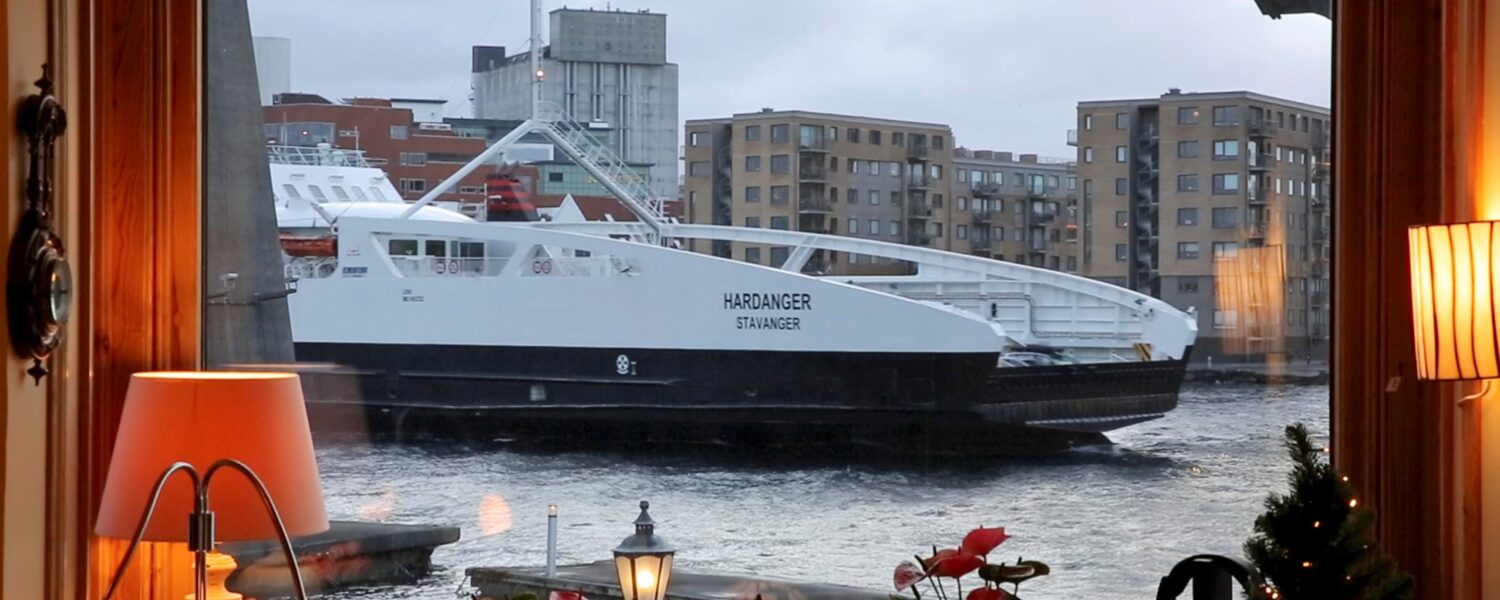Geir Egil Bergjord
Return trip to Stavanger
With a static camera position framed by architecture, Geir Egil Bergjord creates intimate panoramas facing onto the fjord. The calm views, which show water, mountains on the horizon or urban wharf areas, are filmed at different times of the day and in different seasons. We see small movements in the details and some random passersby, before the ferries dramatically break into the pictures – much closer than we had expected.
What might at first look like documentary films of more or less aesthetically pleasing urban environments are compositions that have much in common with historical depictions of landscapes. The pictures are often constructed in three layers like traditional landscape paintings: a detailed foreground, a middle ground where the action takes place, and a bluish background that creates pictorial depth. In addition to water and architecture, the films show contrasts between different types of infrastructure, often with Stavanger’s dominating City Bridge as an aesthetic element. They show how the development of cities and landscapes is marked by our need for transportation and how this development, over time, can result in quite chaotic urban spaces where different considerations exist side-by-side.
The first film shows a ferry gliding slowly and silently towards a quay. The ship takes possession of the entire pictorial plane, in a romantic morning light that brings to mind William Turner’s The Fighting Temeraire from 1838 – a painting that also tells a story about changes in technology and infrastructure. A single soundtrack suddenly breaks the room’s silence with the sound of a ferry scraping against a dock.
In some films we see reflections of a ferry in windows or other glass surfaces for several seconds before the ferry itself comes into view. Some clips show the entire ‘action’ played out in these reflections, and they collide with the passing ferry when it finally becomes visible. These fragmented reflections become a kind of mise en abyme – an image within an image. An attentive viewer will also notice that these films have several internal references, particularly to photography itself. A bicyclist stops and takes a photo of what he sees before him; surveillance cameras are mounted on a column, and a pair of binoculars on a windowsill are directed towards buildings on the far side of the waterway.
The night footage reveals passengers inside the ferries and creates a visual connection between the ferry windows and the illuminated windows of the surrounding buildings. The last film in the exhibition consists of footage shot through the windows of private homes. In one of the scenes, the foreground is reminiscent of a still life with potted plants, lamps and curtains. The composition and well-lit foreground tell us that this is also an important part of the picture; it allows us to imagine who lives here and what is happening ‘behind’ the camera. The unwashed windows create a veil partly occluding the view, as if to remind us that neither the view, the gaze nor the photograph are neutral.
We can recognise this pictorial strategy from Bergjord’s ongoing photo series Private Views, in which he photographs famous monuments through the windows of private homes. In pictures of such things as the Eiffel Tower, the Pyramids of Giza or the Great Wall of China, he deconstructs tourism’s voyeuristic gaze by presenting the monuments as familiar and ordinary sights. But the monument in the films – the ferry – is neither static nor iconic. Yet by giving it the same aesthetic attention as he gives to touristic monuments, Bergjord ends up treating it as a contemporary monument that already has historical status. The many foggy images can also be interpreted as symbolising the fact that ferries are on the verge of disappearing from our visual memory.
The films are shown next to each other in an installation that surrounds the viewer in an up-close and concentrated experience. The large formats, from floor to ceiling, intensify the physical dimensions of the ferries and allow us to move close to the subjects. The films are edited to increase the frequency of the ferries. The screens overlap each other, and the viewers are invited to move around the room, to choose their own viewing angles and create combined readings of the separate films. By letting films of different lengths play in continuous loops, the configurations become random.
The exhibition title Return Trip to Stavanger refers to the actual route of the ferries, but it can also be associated with infrastructural changes in a city over time. Traces of Stavanger’s history as a maritime city are on the verge of disappearing or being replaced by buildings that mimic the picturesque wharf-warehouse architecture. For centuries, we have transported goods and people across the ocean, and this activity has made a strong visual impact on the cityscape. Today, harbour activities are being moved away from the city centre and traffic is funnelled through undersea tunnels. The films show architectural contrasts: the simple wooden structures and industrial buildings closest to the water, and modern housing complexes that are taking over the waterfront for sake of the view. The view facing onto the fjord is no longer characterised by transport culture and its swarms of humanity. The fjord is changing – from a utilised landscape to an aesthetic landscape.
Text by Helga Nyman. She is an art historian and conservator at Stavanger Art Museum.
The art installation is supported by Regional Funding for Visual Arts, Rogaland County Council, The City of Stavanger and Arts Council Norway.
